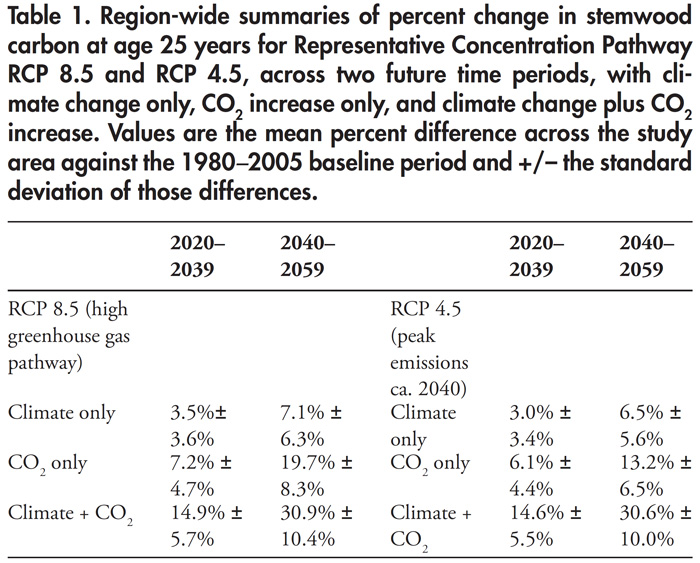| Tweet | Follow @co2science |
Paper Reviewed
Burkhart, H.E., Brooks, E.B., Dinon-Aldridge, H. Sabatia, C.O., Gyawali, N., Wynne, R.H. and Thomas, V.A. 2018. Regional simulations of loblolly pine productivity with CO2 enrichment and changing climate scenarios. Forest Science 64: 349-357.
Loblolly pine forest plantations in the Southeastern United States provide a key source of raw material for wood products made within the USA. They also provide important ecosystem services for the many animals and other plants inhabiting their natural range. How these forests will respond to predicted changes in atmospheric CO2 and climate is therefore a topic of much interest among forest landowners and policymakers.
In a recent paper, Burkhart et al. (2018) examined this question using a model-based approach to simulate "the probable effects of changing climate and increased ambient CO2 concentrations on the productivity of loblolly pine in its natural range to the mid-twenty-first century." The study area encompassed loblolly pine forests from twelve southern US states. Across this region, the researchers applied an empirical growth and yield model to estimate forest response to projected increases in mean annual temperatures of 1.75 to 2.53°C, total annual precipitation changes of -60 to +88 mm, and increases in atmospheric CO2 according to the IPCC's higher-end greenhouse gas emission scenarios (Representative Concentration Pathway (RCP) 4.5 and 8.5).
The model results revealed that both changes in climate and atmospheric CO2 will likely improve the productivity of loblolly pine in the future. Region-wide summaries of the percent change in stemwood carbon at age 25 years for RCP 4.5 and RCP 8.5 are presented in the table below. As shown there, it is likely that "both climate effects and CO2 effects [will have] a positive impact on pine growth," with mean projected productivity increases of 30.4% by mid-century. What is more, the individual effects of these two parameters are additive when both factors are considered together, as "the general percent difference under the combination [of factors] is greater than the sum of the differences under each main effect."
In commenting on their work, Burkhart et al. write that "while there are many caveats that must be considered when interpreting the results, we found that increased productivity of managed loblolly pine in the southeastern United States over [the] coming decades appears highly likely." Furthermore, they note that "the conclusion that ambient CO2 enrichment will likely be a more important driver of increased productivity in planted loblolly pine than climate variation is consistent with past empirical analyses," citing Valentine et al. (1999) and Baldwin et al. (2001). And thus it appears that although predicted global warming and climate change will play some role in enhancing loblolly pine forest productivity, the role of rising atmospheric CO2 in this regard is much bigger.

References
Baldwin, V.C., Burkhart, H.E. Westfall, J.A. and Peterson, K.D. 2001. Linking growth and yield and process models to estimate impact of environmental changes on growth of loblolly pine. Forest Science 47: 77-82.
Valentine, H.T., Amateis, R.L., Burkhart, H.E., Gregoire, T.G., Hollinger, D.Y. and MacFarlane, D.W. 1999. Projecting the growth of loblolly pine in a changing atmosphere. Southern Journal of Applied Forestry 23: 212-216.
Posted 13 December 2018



